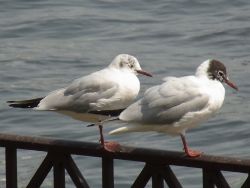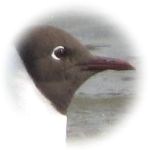
 Most of the seagull's species come mainly from northern Eurasian Continent in autumn and then return to northern breeding grounds in spring.
Most of the seagull's species come mainly from northern Eurasian Continent in autumn and then return to northern breeding grounds in spring.
Among them, Japanese plums are said to account for the majority of small seagull species coming to Japan.
One of the characteristics of the Japanese plum is that the appearance of winter feathers and summer feathers is completely different.
Winter feathers, which are often seen, have a pure white head, dark spots behind their eyes, and red legs and beaks.
It has a slender, streamlined overall, and has a white and lovely face.
On the other hand, Natsuha seems to have a humorous appearance from the back of the eyes to the neck and covered a black hood about 2/3 of the head.
The legs and beaks also turn dark red, and the white eye line with the front is clearly visible around the eyes.
Yurikamome's "gangromake" is a "sign of departure" that indicates that spring has come and is ready to return to the north.
The black gull seen on the Sumida River terrace seems to increase the number of individuals whose head is blacker day by day.
During this period, you can enjoy a unique sight of the "prepared individuals" that are already switching to summer wings and the "relaxing shop" that still retains the image of winter feathers next to each other.

